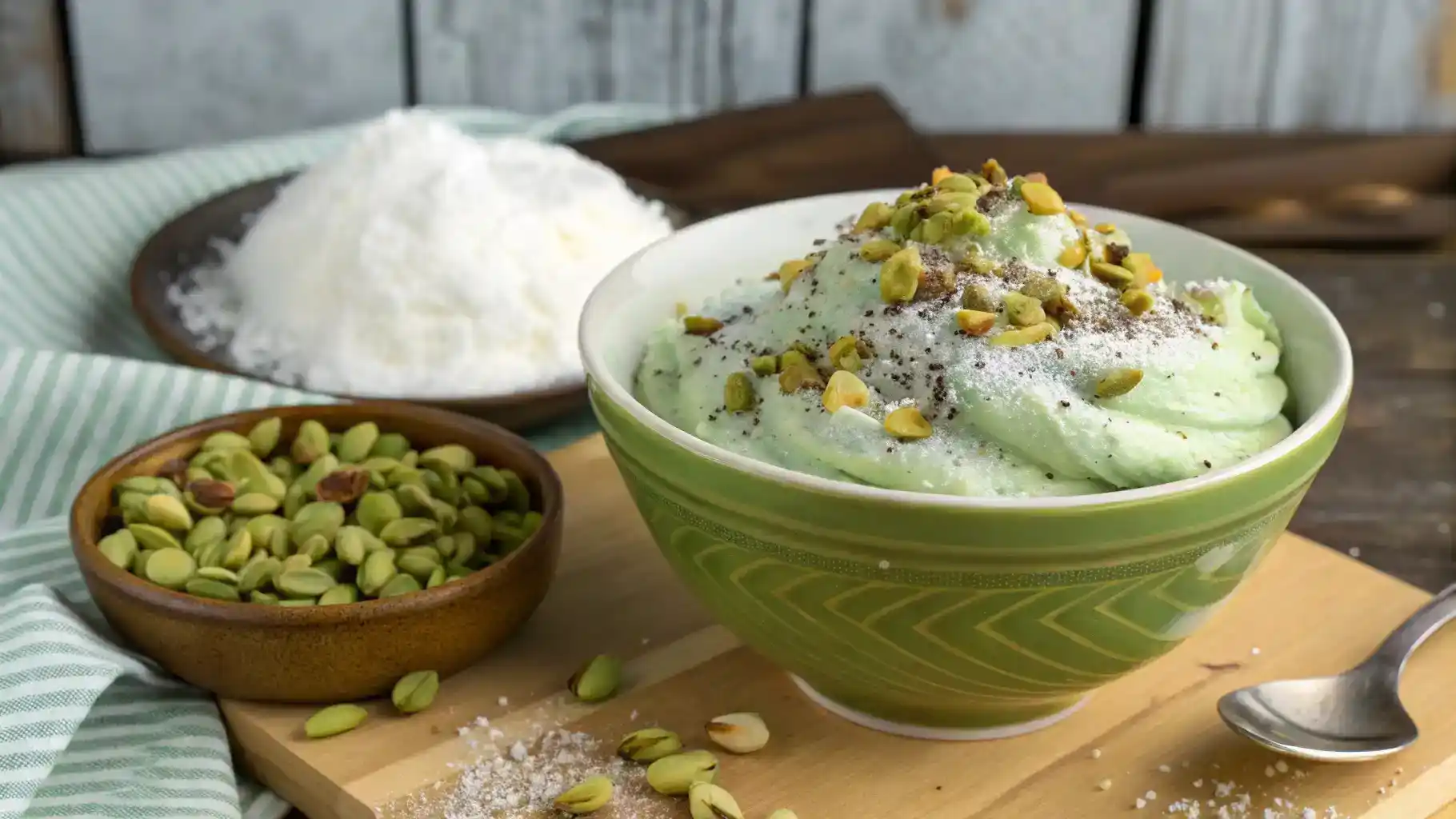Homemade pistachio cream contains 50% pistachio nuts, delivering unmatched flavor that store-bought versions rarely achieve. This Italian specialty, known as Crema al Pistacchio, differs from Nutella by combining white chocolate with pistachios instead of milk chocolate with hazelnuts. The result is a sweet, creamy, and distinctly bright green spread that captures the essence of premium pistachios.
Making this luxurious spread at home requires just 4 ingredients and approximately 10 minutes of active preparation time. Authentic pistachio cream from Sicily is considered the gold standard but often comes with a hefty price tag. The good news is that this chef’s secret recipe produces the same restaurant-quality taste without the premium cost.
A 1/2 cup serving of pistachios provides roughly 6 grams of protein, which helps create that satisfying richness in the final spread. The natural oils from the nuts, when properly blended, contribute to the cream’s smooth, spreadable texture that makes it so versatile.
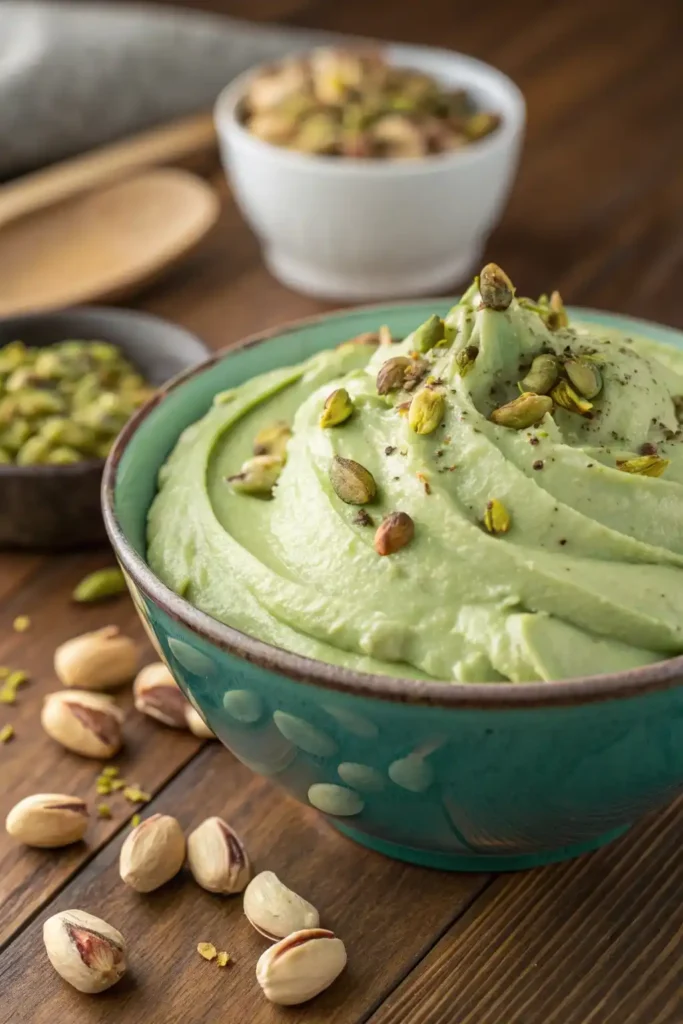
This versatile Italian delicacy isn’t limited to toast spreading. You can use it to fill doughnuts, layer between cake tiers, or incorporate into pastry recipes. The rich pistachio flavor pairs particularly well with vanilla and chocolate bases.
Homemade pistachio cream stays fresh when stored in an airtight container in the refrigerator for up to 4 weeks. To maintain its quality, be sure to use clean utensils each time you scoop from the container. This prevents introducing bacteria that can shorten shelf life.
In the following sections, you’ll learn professional techniques for selecting the right pistachios, achieving silky-smooth texture, and troubleshooting common issues that might arise during preparation. With these detailed instructions, you’ll create a luxurious spread that rivals any imported variety.
Choosing the Right Ingredients for Italian Pistachio Cream
The quality of your homemade pistachio cream depends primarily on using premium ingredients. Unlike commercial versions that often contain fillers and artificial flavors, authentic Italian pistachio cream relies on just a few high-quality components to achieve its distinctive taste and texture.
Raw vs roasted pistachios: what works best
For the richest flavor and most vibrant green color in your pistachio cream, raw pistachios are the ideal choice. Raw, unsalted pistachios provide a blank canvas that allows you to control the final taste profile. Using raw nuts helps retain more of that coveted green color that makes Italian pistachio cream so visually appealing.
Turkish pistachios stand out for their bright green skin and rosy outer layer, making them excellent for vibrant pistachio cream. Sicilian pistachios are often considered the gold standard—particularly those from Bronte, Sicily, sometimes marketed as “green gold” for their exceptional quality. American pistachios (mostly from California, Arizona, and New Mexico) are more readily available and still produce excellent results, albeit with a slightly less vibrant green color.
Regardless of origin, you’ll need to remove the dark, papery skins from the pistachios through blanching:
- Boil the shelled pistachios for approximately 3-4 minutes
- Drain and place them on a clean kitchen towel
- Rub them gently to loosen the skins
- Separate the pistachios from the skins and discard the latter
This step is crucial as leaving the skins on will result in brown flecks that affect both appearance and texture. Blanching softens the pistachios slightly, making it easier to achieve a smooth consistency.
If you’re short on time, you can use roasted pistachios, but understand that the final product will have a more muted color and a toastier, less bright flavor profile. Many chefs recommend a very light toasting of raw pistachios (5-7 minutes at 325°F/160°C) after blanching to enhance flavor while maintaining color.
Best white chocolate brands for smooth texture
The white chocolate component is equally important for achieving that silky-smooth texture characteristic of premium Italian pistachio cream. Look for white chocolate with a high percentage of cocoa butter rather than one primarily made of sugar.
Several brands consistently deliver excellent results in homemade pistachio cream:
- Callebaut: Professional-grade with exceptional melting properties
- Ghirardelli: Widely available with good cocoa butter content
- Valrhona: Premium quality with rich, complex flavor notes
- Green & Black’s: Organic option with balanced sweetness
Avoid cooking white chocolate, which often lacks the necessary cocoa butter content for a smooth melt. Instead, select chocolate labeled for eating that you personally enjoy the taste of.
For melting, combine your white chocolate with butter and milk in a heatproof bowl over gently simmering water. Stir occasionally until completely melted, then remove from heat before incorporating with your processed pistachios. This method ensures a smooth integration without any graininess.
Remember that pistachio cream isn’t as ubiquitous as peanut or almond butter in grocery stores, which is precisely why making your own allows for complete control over ingredients and quality. By selecting premium pistachios and high-quality white chocolate, your homemade version will surpass most commercial options in both flavor and texture.
Preparing Pistachios Like a Chef
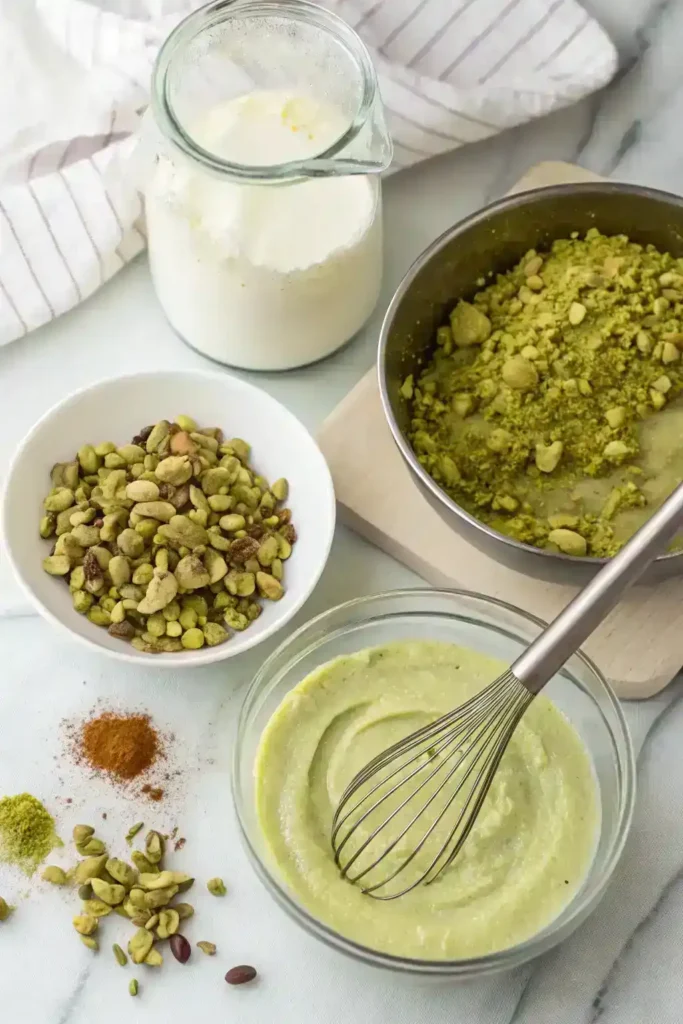
The path to exceptional pistachio cream begins well before the blending stage – it starts with properly prepared pistachios. The most crucial step involves removing those papery skins that cling to the nuts. This seemingly simple task determines whether you’ll end up with a grainy, brownish spread or a silky, vibrant green delicacy.
How to peel pistachios for a smooth finish
Removing pistachio skins is essential for two reasons. First, these dark skins contain compounds that create a slightly bitter flavor and musty aroma when concentrated. Second, the skins produce tiny brown flecks that affect both the texture and color of your final cream.
For professional-quality results:
- Begin with raw pistachios – Shelled varieties work well, though pistachios still in shells often retain more vibrant color
- Sort through the nuts – Discard any that appear withered, blackened, or unsuitable
- Blanch in boiling water – Submerge for exactly 3-4 minutes
- Shock in cold water – Transfer immediately to an ice bath to halt cooking
- Dry thoroughly – Spread on a clean kitchen towel
After blanching, place the cooled pistachios in the center of a clean kitchen towel (rougher textures work best), fold the towel over, and rub vigorously. For stubborn skin bits that remain, gently squeeze individual nuts – the skin should slip off with minimal effort.
Boiling method vs soaking method
While blanching represents the standard approach for peeling pistachios, two specific methods yield slightly different results:
Traditional Boiling Method: Bring water to a full boil, add pistachios for 3-4 minutes, then cool immediately. This efficient technique quickly separates the skins but requires precise timing. Even 30 seconds too long can make pistachios mushy and difficult to work with.
Gentle Soaking Method: Soak pistachios in cold water for 5 minutes, then heat them in a wide skillet until the water reaches just below simmering. This approach gives more control and reduces the risk of over-softening. Test a few pistachios to determine when the skins have loosened enough.
Both methods achieve the same goal, but the soaking method offers a wider margin of error for home cooks.
After peeling, dry the pistachios thoroughly before processing. A light toasting (5-10 minutes at 325°F/160°C) can enhance flavor while removing excess moisture. Watch carefully – pistachios should maintain their green color without browning.
The peeling process requires patience but delivers remarkable results. Properly peeled pistachios create that signature vibrant green cream that’s impossible to achieve otherwise. Be sure to set aside about 20-30 minutes for this step to ensure the best outcome.
Blending the Perfect Pistachio Cream
The transformation from prepared pistachios to silky, luxurious cream requires patience and attention to detail. With the right technique, your homemade pistachio cream will rival any gourmet version.
Step-by-step blending process
Follow these steps for blending success:
- Place your peeled pistachios in a food processor along with 1-2 tablespoons powdered sugar. Pulse until they form a consistent, fine crumb texture.
- Add ¼ cup of milk and continue processing. This small amount of liquid helps create the foundation of your pistachio paste.
- Process continuously for 5-10 minutes, stopping occasionally to scrape down the sides. The pistachios will gradually transform from crumbs into a smoother paste.
- Meanwhile, melt your white chocolate with butter and remaining milk in a small saucepan over low heat, stirring occasionally until completely smooth.
- Transfer your pistachio paste to a blender, add the melted white chocolate mixture and blend until extraordinarily smooth and glossy.
The extended blending time is crucial – many home cooks stop processing too early. To achieve truly smooth results, expect to blend for up to 20-30 minutes total across all stages. This isn’t excessive; the prolonged blending releases natural oils from the pistachios, creating that signature silky texture.
How to avoid a gritty texture
A common issue with homemade nut creams is grittiness. To prevent this:
- Use high-quality pistachios with skins completely removed
- Ensure adequate blending time – patience is essential
- Incorporate warm (not hot) melted chocolate to maintain ideal temperature
- Scrape down the sides of your processor frequently to catch unprocessed pieces
The temperature of your ingredients matters significantly. When pistachios are processed for extended periods, the natural warmth generated helps release their oils, creating a smoother consistency. Similarly, adding warm white chocolate mixture (rather than hot or cold) helps maintain this optimal temperature range.
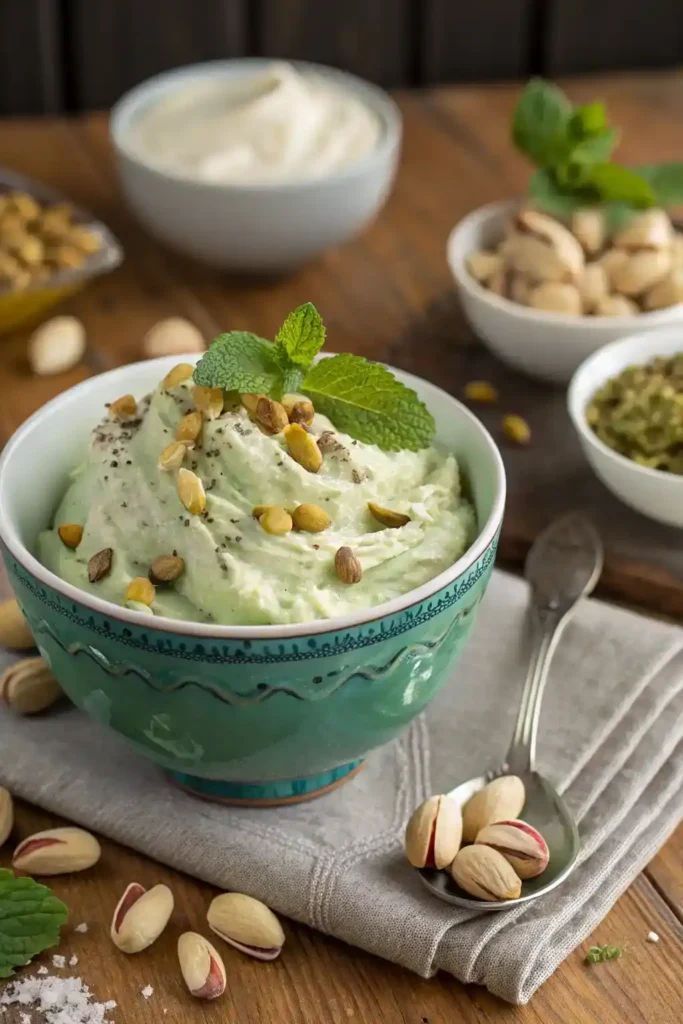
When to use a food processor vs blender
Food processors and blenders serve different purposes when making pistachio cream:
Food processors excel at breaking down whole pistachios and forming the initial paste. Their wide, flat blades effectively pulverize nuts without overheating them.
Blenders create a smoother final product during the emulsification stage. Their vortex-creating design incorporates liquids more thoroughly than food processors.
For best results, use both appliances in sequence – food processor first, then blender for finishing. If you have only one appliance, a food processor with progressive blending (starting slow, gradually increasing speed) provides acceptable results, though slightly less smooth.
Be sure to label your container with the date of preparation. This helps you keep track of freshness as you enjoy your homemade creation over the following weeks.
Troubleshooting Common Pistachio Cream Issues
Even with careful preparation, homemade pistachio cream occasionally develops texture or appearance problems. The good news is that most issues can be fixed with simple adjustments.
Why your cream is too runny or too thick
Consistency problems are common when making pistachio cream at home. The texture should be smooth and spreadable, similar to a high-quality chocolate spread.
If your pistachio cream is too runny:
- Continue processing for an additional 2-3 minutes to develop more structure
- Add more pistachios (about ¼ cup) to thicken the mixture
- Add 1-2 tablespoons of white chocolate, which will solidify as it cools
- Refrigerate the cream for 30 minutes to help it set
If your pistachio cream is too thick:
- Add milk in ½ tablespoon increments until reaching desired consistency
- Use a kitchen scale for accurate measurements in future batches
- Warm the cream gently in the microwave (5 seconds at a time) to restore spreadability
- Make sure you’ve blended long enough to release the natural oils from the pistachios
Fixing color and texture problems
The vibrant green color is a signature feature of quality pistachio cream. Brown or dull-colored cream typically results from:
- Using roasted rather than raw pistachios
- Incomplete removal of brown skins
- Overheating during the blending process
For disappointing color, try using Turkish or Sicilian pistachios in your next batch, as these varieties naturally yield brighter color than California pistachios. For already-made cream that’s too brown, a tiny pinch of matcha powder can enhance the green hue.
Texture problems often manifest as graininess or separation. For smoother results:
- Blend for at least 5-10 minutes total – the extra time makes a significant difference
- Strain through a fine mesh sieve to remove any remaining skin particles
- If oil separation occurs, stir thoroughly before using – this is normal with nut-based spreads
When oil completely separates (appearing as bright green oil around nut solids), avoid adding water as this worsens the problem. Instead, continue processing with a small amount of neutral oil to re-emulsify the mixture.
Remember that homemade pistachio cream won’t be quite as shelf-stable as commercial versions with preservatives. If stored properly in an airtight container, it should maintain its quality for several weeks in the refrigerator.
How to Store Homemade Pistachio Cream Properly
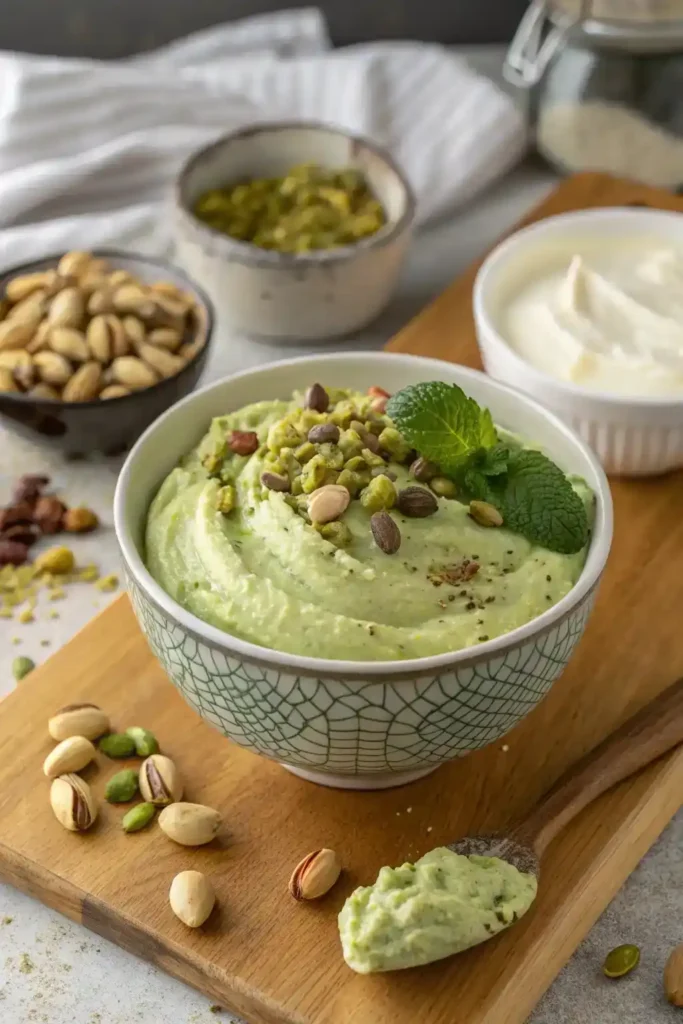
Proper storage keeps your freshly made pistachio cream vibrant and flavorful. After spending time preparing this delicious spread, you’ll want to maintain its quality as long as possible.
Fridge vs pantry: what’s best
Your storage choice depends on how quickly you plan to use your pistachio cream.
For short-term storage (1-2 weeks), keeping your pistachio cream in a cool, dry pantry works well, provided the lid is tightly sealed. This method maintains the cream’s smooth, spreadable consistency without additional preparation before use.
For longer preservation, refrigeration is the safer option. Homemade pistachio cream generally stays fresh in the refrigerator for:
- 2-4 weeks according to most home recipes
- Up to 6-8 months according to professional producers
Refrigerated pistachio cream may develop small oil bubbles over time due to its natural pistachio oils. This is completely normal and doesn’t indicate spoilage. To restore its smooth texture, simply let the cream sit at room temperature for 5-10 minutes and stir thoroughly before use.
How long it lasts and signs of spoilage
Unopened commercial pistachio cream can last 12-24 months when properly stored. Once opened, the countdown begins—even with refrigeration.
Watch for these telltale signs that your pistachio cream has gone bad:
- Unusual smell: Fresh pistachio cream has a pleasant, nutty aroma. Any sour, musty, or rancid odor indicates spoilage.
- Color changes: Your cream turning brown or developing dark spots isn’t a good sign.
- Texture deterioration: Excessive oil separation beyond what can be reincorporated by stirring, or any grainy, dried-out consistency suggests it’s time for a new batch.
- Mold growth: Any visible mold means immediate disposal.
Be sure to use clean utensils when scooping out your pistachio cream to prevent introducing bacteria that can accelerate spoilage. With proper handling, your homemade pistachio cream will remain delicious until the last spoonful.
Conclusion
Homemade pistachio cream delivers rich flavor that store-bought versions simply cannot match. The 50% pistachio content creates a deep, authentic taste that makes the effort worthwhile. Throughout this guide, we’ve explored techniques for creating this luxurious Italian delicacy from selecting premium ingredients to achieving that perfect silky texture.
Those extra minutes spent removing pistachio skins reward you with vibrant green color and smooth consistency characteristic of authentic Crema al Pistacchio. The natural oils released during proper blending contribute to the cream’s rich mouthfeel, while high-quality white chocolate with substantial cocoa butter content ensures perfect spreadability.
A 1/2 cup of pistachios provides approximately 6 grams of protein, contributing to the satisfying richness of the final product. When properly prepared, these nutritional benefits combine with extraordinary flavor to create a truly special spread.
Pistachio cream’s versatility makes it worth the effort. Beyond toast and breakfast pastries, this delightful spread elevates desserts like cakes, cannoli, and gelato to restaurant-quality status. The distinctive bright green color adds visual appeal to any dish.
Proper storage in an airtight container preserves your pistachio cream’s freshness for up to 4 weeks in the refrigerator. Be sure to use clean utensils each time to prevent introducing bacteria that can shorten shelf life.
Homemade pistachio cream represents one of those special treats that connects us to culinary traditions while offering significantly better flavor than commercial alternatives. Though store-bought versions might be convenient, nothing compares to the satisfaction of creating this “green gold” in your own kitchen.
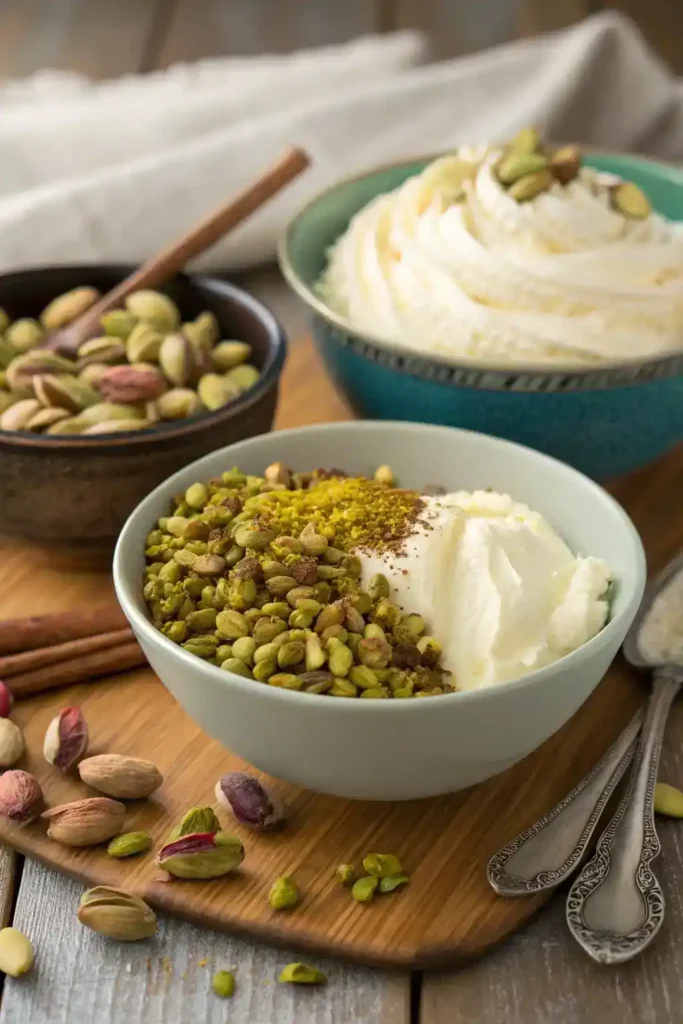
FAQs
Q1. How can I make pistachio cream at home? To make pistachio cream, blend pistachios and sugar until powdery. Melt white chocolate with milk, add to the blender, and mix. Incorporate butter and blend until smooth. Refrigerate in a clean jar until cold.
Q2. What are the key ingredients for authentic pistachio cream? Authentic pistachio cream typically contains pistachios (about 45%), sugar, milk powder, vegetable fats, olive oil, and emulsifiers. High-quality versions use minimal additives and focus on premium pistachios for the best flavor.
Q3. How do I achieve a smooth texture in my homemade pistachio cream? For a smooth texture, thoroughly remove pistachio skins, blend for an extended period (up to 20-30 minutes total), and use both a food processor and blender. Incorporate warm melted chocolate to maintain an ideal temperature during blending.
Q4. What’s the best way to store homemade pistachio cream? For short-term storage (1-2 weeks), keep pistachio cream in a cool, dry pantry in a tightly sealed container. For longer preservation, refrigerate for up to 4 weeks. Always use clean utensils to prevent bacterial growth.
Q5. How can I tell if my pistachio cream has gone bad? Signs of spoiled pistachio cream include an unusual sour or rancid smell, color changes (turning brown or developing dark spots), texture deterioration (excessive oil separation or graininess), and visible mold growth. If you notice any of these signs, it’s best to discard the cream.

